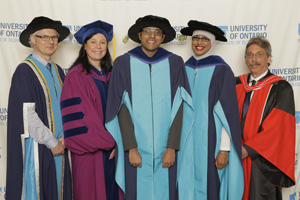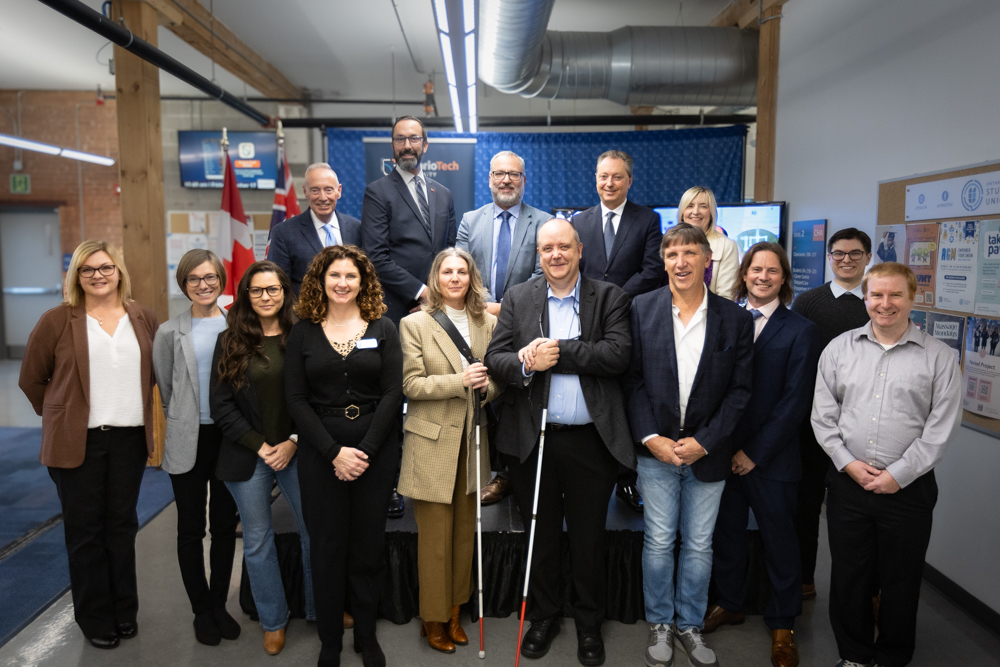UOIT’s first Nuclear Engineering PhDs focus research on radiation detection and safety
June 16, 2014

On June 5, two University of Ontario Institute of Technology (UOIT) students became the first to receive their Doctor of Philosophy degrees in Nuclear Engineering.
Taking the stage at Convocation were Dr. Nafisah Khan, who earned her Bachelor of Engineering in Nuclear Engineering (BEng) in 2007, and her Master of Applied Science (MASc) in Nuclear Engineering in 2010; and Dr. Fawaz Ali, who received his BEng in Nuclear Engineering in 2007 and his Master of Science (MSc) in Modelling and Computational Science in 2010. All degrees were conferred by UOIT."It's my tremendous pleasure to congratulate Nafisah and Fawaz on this important achievement and milestone as the first PhD graduates in the Faculty of Energy Systems and Nuclear Science (FESNS)," said Dr. Brent Lewis, Dean, FESNS. “The research of both candidates has made significant contributions to the improvement of radiation detection methods, environmental radiation protection and occupational safety in nuclear power plants and other nuclear facilities.”
With nuclear energy being a clean and reliable power source, Dr. Khan chose to pursue a career in Nuclear Engineering because of nuclear’s many power generation advantages. Her thesis, titled A New Approach to Neutron Spectrometry with Multi-Elemental Scintillators, included both experimental and simulation work.
Through her research, Dr. Khan pioneered the investigation of new scintillating (light-producing) materials for the development of a state-of-the-art neutron spectrometer/dosimeter, an instrument that detects radiation and measures the dose of radiation emitted by a radioactive source.
Dr. Khan credits her success to her PhD supervisor, Dr. Rachid Machrafi, Assistant Professor, FESNS, who motivated her to achieve research excellence.
“The development of such a system has been a challenging and important goal in the field of radiation measurement and protection for a long time, particularly when it comes to size, performance and accuracy,” said Dr. Machrafi. It was a great pleasure watching Nafisah grow as a student to become a brilliant Engineer. She worked tremendously hard to get where she is today. I know she will continue to do great things in her lifetime, and I look forward to watching where her career takes her."
Additionally, Dr. Khan credits her success to Dr. George Bereznai, Professor and Director, Industry Training Program, and Founding Dean, FESNS and to many of the professors who have been supportive and provided guidance along the way.
"The University of Ontario Institute of Technology has provided me with the foundation from my undergraduate studies to meet my research aspirations in graduate studies," said Dr. Khan. "UOIT has also given me the opportunity to share my research nationally and internationally."
Dr. Fawaz Ali’s thesis, entitled Design and characterization of next-generation tissue equivalent proportional counters for use in low energy neutron fields, also focused on improving radiation detection. In nuclear power plants and other nuclear facilities, the radiation dose levels must be measured in the parts of the facility where workers are present.
“Current radiation detector technologies can accurately measure these radiation dose levels, but these technologies are quite large in size, thereby forcing workers to walk around with large instruments in order to make the radiation dose-level measurements,” Dr. Ali explained.
His research focused on:
- Coming up with conceptual designs for compact and portable instruments that can make the necessary radiation dose-level measurements
- Quantifying the accuracy of these measurements in realistic nuclear power plant radiation fields, using Monte Carlo radiation transport simulation codes (computational algorithms)
“A prime objective of the University Network of Excellence in Nuclear Engineering (UNENE), of which UOIT is a member, as well as the Natural Sciences and Engineering Research Council of Canada, is the training of highly qualified personnel to contribute to a society and national economy driven by science and technological innovation,” said Dr. Anthony Waker, Professor, FESNS, and one of Dr. Ali’s PhD Supervisors. “The graduation and awarding of a PhD to Fawaz Ali represents a significant moment in the development of the graduate research program of the Faculty of Energy Systems and Nuclear Science and the UNENE/NSERC-funded Industrial Research Chairs in Health Physics and Environmental Safety held within the Faculty.”
Dr. Ali’s work centered on using advanced computer modelling tools to design a new class of tissue equivalent proportional counter (TEPC) suitable for monitoring neutrons in the mixed radiation field environments encountered in nuclear power plants and other nuclear facilities.
“Accurate neutron monitoring remains a significant technical problem and Dr. Ali’s work is an important step in the direction of providing improved instrumentation for occupational safety, not only to nuclear energy workers but also research scientists and technologists who work with high-energy particle accelerators or nuclear materials,” said Dr. Waker. “Dr. Ali is certainly to be congratulated for his state-of-the-art work, which included a highly regarded critical examination of the suitability of different advanced computational codes used for modelling radiation detectors such as TEPCs.”
Dr. Ali credits Dr. Waker and his other PhD Supervisor, Dr. Ed Waller, for making his graduate studies experience at UOIT a rewarding one. “I had an opportunity to work under the supervision of recognized experts in the field of radiological and health physics, which enabled me to focus my doctoral studies on designing advanced radiation detector technologies.”



